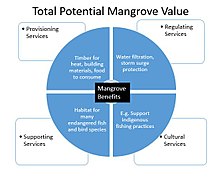In ethics and the social sciences, value theory involves various approaches that examine how, why, and to what degree humans value things and whether the object or subject of valuing is a person, idea, object, or anything else. Within philosophy, it is also known as ethics or axiology.

Natural capital is the world's stock of natural resources, which includes geology, soils, air, water and all living organisms. Some natural capital assets provide people with free goods and services, often called ecosystem services. All of these underpin our economy and society, and thus make human life possible.

Environmental economics is a sub-field of economics concerned with environmental issues. It has become a widely studied subject due to growing environmental concerns in the twenty-first century. Environmental economics "undertakes theoretical or empirical studies of the economic effects of national or local environmental policies around the world. ... Particular issues include the costs and benefits of alternative environmental policies to deal with air pollution, water quality, toxic substances, solid waste, and global warming."

Ecological economics, bioeconomics, ecolonomy, eco-economics, or ecol-econ is both a transdisciplinary and an interdisciplinary field of academic research addressing the interdependence and coevolution of human economies and natural ecosystems, both intertemporally and spatially. By treating the economy as a subsystem of Earth's larger ecosystem, and by emphasizing the preservation of natural capital, the field of ecological economics is differentiated from environmental economics, which is the mainstream economic analysis of the environment. One survey of German economists found that ecological and environmental economics are different schools of economic thought, with ecological economists emphasizing strong sustainability and rejecting the proposition that physical (human-made) capital can substitute for natural capital.
Contingent valuation is a survey-based economic technique for the valuation of non-market resources, such as environmental preservation or the impact of externalities like pollution. While these resources do give people utility, certain aspects of them do not have a market price as they are not directly sold – for example, people receive benefit from a beautiful view of a mountain, but it would be tough to value using price-based models. Contingent valuation surveys are one technique which is used to measure these aspects. Contingent valuation is often referred to as a stated preference model, in contrast to a price-based revealed preference model. Both models are utility-based. Typically the survey asks how much money people would be willing to pay to maintain the existence of an environmental feature, such as biodiversity.

Ecosystem services are the various benefits that humans derive from healthy ecosystems. These ecosystems, when functioning well, offer such things as provision of food, natural pollination of crops, clean air and water, decomposition of wastes, or flood control. Ecosystem services are grouped into four broad categories of services. There are provisioning services, such as the production of food and water. Regulating services, such as the control of climate and disease. Supporting services, such as nutrient cycles and oxygen production. And finally there are cultural services, such as spiritual and recreational benefits. Evaluations of ecosystem services may include assigning an economic value to them.

A shadow price is the monetary value assigned to an abstract or intangible commodity which is not traded in the marketplace. This often takes the form of an externality. Shadow prices are also known as the recalculation of known market prices in order to account for the presence of distortionary market instruments. Shadow prices are the real economic prices given to goods and services after they have been appropriately adjusted by removing distortionary market instruments and incorporating the societal impact of the respective good or service. A shadow price is often calculated based on a group of assumptions and estimates because it lacks reliable data, so it is subjective and somewhat inaccurate.
The embedding effect is an issue in environmental economics and other branches of economics where researchers wish to identify the value of a specific public good using a contingent valuation or willingness-to-pay (WTP) approach. The problem arises because public goods belong to society as a whole, and are generally not traded in the market. Because market prices cannot be used to value them, researchers ask a sample of people how much they are willing to pay for the public good, wildlife preservation for example. The results can be misleading because of the difficulty, for individual society members, of identifying the particular value that they attach to one particular thing which is embedded in a collection of similar things. A similar problem occurs with a wider selection of public goods. The embedding effect suggests the contingent valuation method is not an unbiased approach to measuring policy impacts for cost-benefit analysis of environmental, and other government policies.
Ecological goods and services (EG&S) are the economical benefits arising from the ecological functions of ecosystems. Such benefits accrue to all living organisms, including animals and plants, rather than to humans alone. However, there is a growing recognition of the importance to society that ecological goods and services provide for health, social, cultural, and economic needs.
Non-use value is the value that people assign to economic goods even if they never have and never will use it. It is distinguished from use value, which people derive from direct use of the good. The concept is most commonly applied to the value of natural and built resources.

Payments for ecosystem services (PES), also known as payments for environmental services, are incentives offered to farmers or landowners in exchange for managing their land to provide some sort of ecological service. They have been defined as "a transparent system for the additional provision of environmental services through conditional payments to voluntary providers". These programmes promote the conservation of natural resources in the marketplace.

The Economics of Ecosystems and Biodiversity (TEEB) was a study led by Pavan Sukhdev from 2007 to 2011. It is an international initiative to draw attention to the global economic benefits of biodiversity. Its objective is to highlight the growing cost of biodiversity loss and ecosystem degradation and to draw together expertise from the fields of science, economics and policy to enable practical actions. TEEB aims to assess, communicate and mainstream the urgency of actions through its five deliverables—D0: science and economic foundations, policy costs and costs of inaction, D1: policy opportunities for national and international policy-makers, D2: decision support for local administrators, D3: business risks, opportunities and metrics and D4: citizen and consumer ownership.
Earth Economics is a 501(c)(3) non-profit formally established in 2004 and headquartered in Tacoma, Washington, United States. The organization uses natural capital valuation to help decision makers and local stakeholders to understand the value of natural capital assets. By identifying, monetizing, and valuing natural capital and ecosystem services.

Pavan Sukhdev is an Indian environmental economist whose field of studies include green economy and international finance. He was the Special Adviser and Head of UNEP's Green Economy Initiative, a major UN project suite to demonstrate that greening of economies is not a burden on growth but rather a new engine for growing wealth, increasing decent employment, and reducing persistent poverty. Pavan was also the Study Leader for the ground breaking TEEB study commissioned by G8+5 and hosted by UNEP. Under his leadership, TEEB sized the global problem of biodiversity loss and ecosystem degradation in economic and human welfare terms, and proposed solutions targeted at policy-makers, administrators, businesses and citizens. TEEB presented its widely acclaimed Final Report suite at the UN meeting by Convention on Biological Diversity (CBD) in Nagoya, Japan.
Natural capital accounting is the process of calculating the total stocks and flows of natural resources and services in a given ecosystem or region. Accounting for such goods may occur in physical or monetary terms. This process can subsequently inform government, corporate and consumer decision making as each relates to the use or consumption of natural resources and land, and sustainable behaviour.

Ian Bateman OBE US-NAS FBA FEAERE FRSA FRSB is a professor of environmental economics at the Land, Environment, Economics and Policy (LEEP) Institute at the University of Exeter. He is chief editor of the journal "Environmental and Resource Economics". He was formerly a member of the Natural Capital Committee, a member of the Defra Science Advisory Council, and director of the Centre for Social and Economic Research on the Global Environment (CSERGE).

The value of Earth, i.e. the net worth of our planet, is a debated concept both in terms of the definition of value, as well as the scope of "Earth". Since most of the planet's substance is not available as a resource, "earth" has been equated with the sum of all ecosystem services as evaluated in ecosystem valuation or full-cost accounting.

Clive L. Spash is an ecological economist. He currently holds the Chair of Public Policy and Governance at Vienna University of Economics and Business, appointed in 2010. He is also Editor-in-Chief of the academic journal Environmental Values.
Susana Mourato is a professor of environmental economics at the London School of Economics and Political Science. She holds a leader position at the Grantham Research Institute on Climate Change and the Environment.

Natural resource valuation is a process of providing of benefits, costs, damage of or to natural and environmental resources. It has a fundamental role in the practice of cost-benefit analysis of health, safety, and environmental issues.












